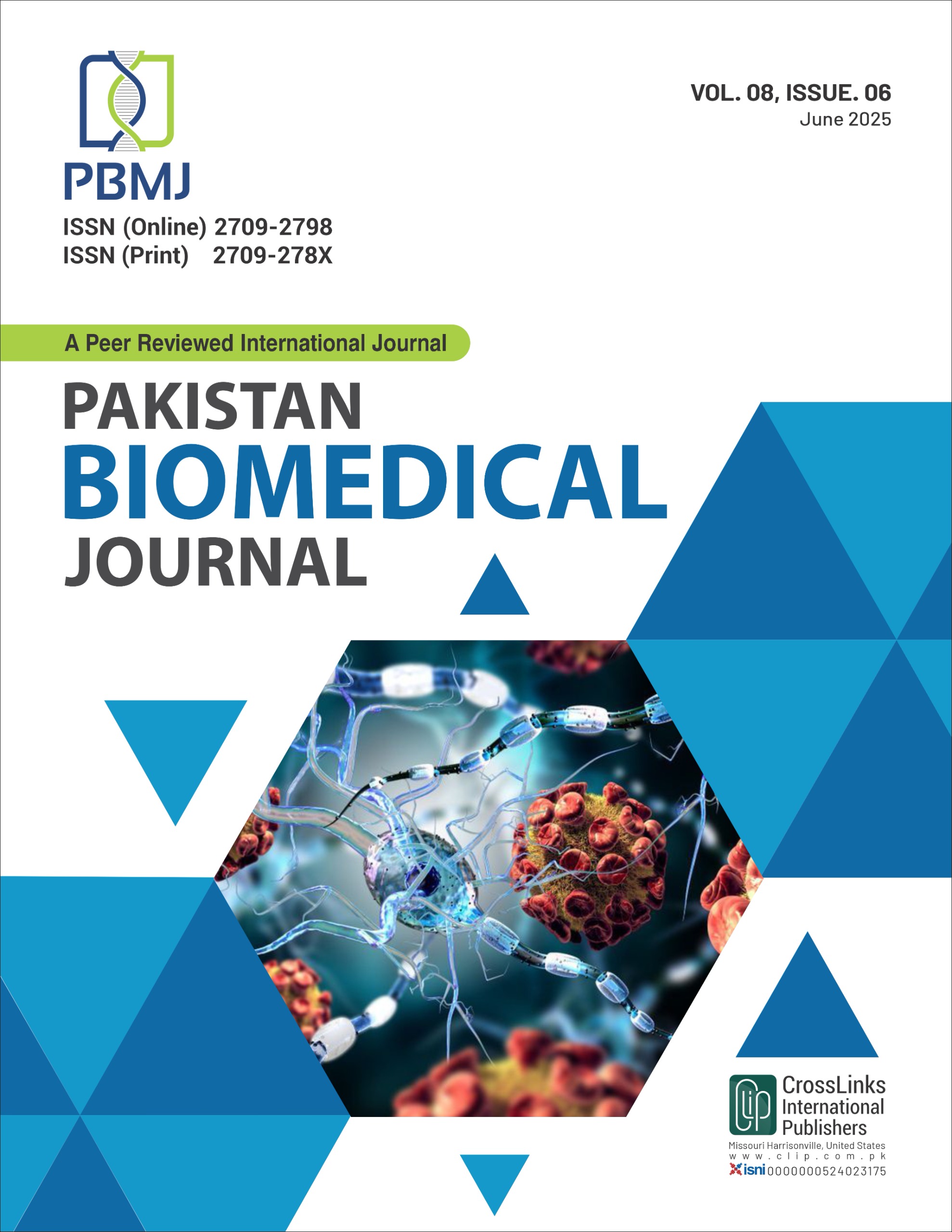Parental Perceptions of Sensory Avoidance and Sleep Disturbances among Autistic Children in Lahore: A Cross-sectional Study
Parental Perceptions of Sensory Avoidance and Sleep Disturbances among Autistic Children
DOI:
https://doi.org/10.54393/pbmj.v8i6.1258Keywords:
Sensory Processing, Sleep Habits, Pediatric Sleep Problems, Sensory Avoidance Behaviours in Autistic ChildrenAbstract
As literature shows, children with autism often experience sensory processing difficulties and sleep disturbances. Objectives: To determine parent-reported sensory avoidance behaviours and sleep habits in school-aged children with autism spectrum disorder in Lahore. Methods: This observational cross-sectional study was conducted on 249 autistic children. Outcome measures of this study were the prevalence of sensory avoidance behaviours and sleep habits. The standardized tools were the Short Sensory Profile (SSP) and the Children's Sleep Habits Questionnaire (CSHQ) to assess the sensory avoidance behaviours and sleep problems. Data were analyzed by using SPSS version 27.0. Results: 38% were aged 3-7 years, and 61% were aged 8–12 years. Parent reports showed that 17% of children exhibited probable differences and 53% exhibited significant differences in tactile sensory avoidance behaviours. Movement sensitivity issues were definite in 54% and probable in 30% of children. Regarding auditory sensory avoidance, 55% showed significant changes, and 1% showed probable changes. For visual and auditory sensory behaviours, only 44% showed typical performance. Overall, 74% of children demonstrated definite sensory avoidance behaviours across multiple domains, while 8% showed some level of sensory avoidance. Additionally, 20% did not display low energy behaviours. Regarding sleep habits, 16% had typical sleep patterns, 3% faced sleep issues at a minimum level, 22% faced sleep issues at an intermediate level, and the remaining 57% faced sleep issues at a severe level. A p-value was >0.05. Significant association between sensory avoidance behaviour and sleep habits. Conclusion: Sensory avoidance behaviour had a significant association with sleep habits.
References
Sauer AK, Stanton J, Hans S, Grabrucker A. Autism spectrum disorders: etiology and pathology. Exon Publications. 2021 Aug: 1-5. doi: 10.36255/exonpublications.autismspectrumdisorders.2021.etiology. DOI: https://doi.org/10.36255/exonpublications.autismspectrumdisorders.2021.etiology
Amaral DG. Examining the causes of autism. In Cerebrum: The Dana forum on brain science. 2017 Jan; (2017): cer-01.
Bhat S, Acharya UR, Adeli H, Bairy GM, Adeli A. Autism: cause factors, early diagnosis and therapies. Reviews in the Neurosciences. 2014 Dec; 25(6): 841-50. doi: 10.1515/revneuro-2014-0056. DOI: https://doi.org/10.1515/revneuro-2014-0056
Masi A, DeMayo MM, Glozier N, Guastella AJ. An overview of autism spectrum disorder, heterogeneity and treatment options. Neuroscience Bulletin. 2017 Apr; 33: 183-93. doi: 10.1007/s12264-017-0100-y. DOI: https://doi.org/10.1007/s12264-017-0100-y
Nkonyane F, Gurayah T, Lingah T. Challenges and coping strategies of parents of children with autism spectrum disorder in Eswatini. Journal of Child and Adolescent Mental Health. 2021 Sep; 33(1-3): 32-41. doi: 10.2989/17280583.2023.2259428. DOI: https://doi.org/10.2989/17280583.2023.2259428
Taylor MJ, Rosenqvist MA, Larsson H, Gillberg C, D’Onofrio BM, Lichtenstein P et al. Etiology of autism spectrum disorders and autistic traits over time. Journal of the American Medical Association Psychiatry. 2020 Sep; 77(9): 936-43. doi: 10.1001/jamapsychiatry.2020.0680. DOI: https://doi.org/10.1001/jamapsychiatry.2020.0680
Van den Boogert F, Klein K, Spaan P, Sizoo B, Bouman YH, Hoogendijk WJ et al. Sensory processing difficulties in psychiatric disorders: A meta-analysis. Journal of Psychiatric Research. 2022 Jul; 151: 173-80. doi: 10.1016/j.jpsychires.2022.04.020. DOI: https://doi.org/10.1016/j.jpsychires.2022.04.020
Ilić-Savić I, Petrović-Lazić M, Resimić R. Sensory integration and its significance for functioning and development of children’s speech. Medicinski Pregled. 2021; 74(5-6): 205-10. doi: 10.2298/MPNS2106205I. DOI: https://doi.org/10.2298/MPNS2106205I
Mahaseth PK and Choudhary A. Sensory Integration Therapy Verses Conventional Physical Therapy Among Children with Cerebral Palsy On Gross Motor Function-A Comparative Randomized Controlled Trial. Annals of the Romanian Society for Cell Biology. 2021 Apr; 25(4).
Kuhlthau K, Orlich F, Hall TA, Sikora D, Kovacs EA, Delahaye J et al. Health-related quality of life in children with autism spectrum disorders: Results from the autism treatment network. Journal of Autism and Developmental Disorders. 2010 Jun; 40: 721-9. doi: 10.1007/s10803-009-0921-2. DOI: https://doi.org/10.1007/s10803-009-0921-2
Halstead EJ, Joyce A, Sullivan E, Tywyn C, Davies K, Jones A et al. Sleep disturbances and patterns in children with neurodevelopmental conditions. Frontiers in Pediatrics. 2021 Mar; 9: 637770. doi: 10.3389/fped.2021.637770. DOI: https://doi.org/10.3389/fped.2021.637770
Draudvilienė L, Sosunkevič S, Daniusevičiūtė-Brazaitė L, Burkauskienė A, Draudvila J. The benefit assessment of the physiotherapy sessions for children with autism spectrum disorder. Baltic Journal of Sport and Health Sciences. 2020 Nov; 3(118): 25-32. doi: 10.33607/bjshs.v3i118.971. DOI: https://doi.org/10.33607/bjshs.v3i118.971
Warutkar VB, Kovela RK, Warutkar V. Review of sensory integration therapy for children with cerebral palsy. Cureus. 2022 Oct; 14(10). doi: 10.7759/cureus.30714. DOI: https://doi.org/10.7759/cureus.30714
Guller B and Yaylaci F. Eating and sleep problems, related factors, and effects on the mental health of the parents in children with autism spectrum disorder. International Journal of Developmental Disabilities. 2024 May; 70(3): 406-15. doi: 10.1080/20473869.2022.2095689. DOI: https://doi.org/10.1080/20473869.2022.2095689
Griffin ZA, Boulton KA, Thapa R, DeMayo MM, Ambarchi Z, Thomas E et al. Atypical sensory processing features in children with autism, and their relationships with maladaptive behaviors and caregiver strain. Autism Research. 2022 Jun; 15(6): 1120-9. doi: 10.1002/aur.2700. DOI: https://doi.org/10.1002/aur.2700
Holingue C, Volk H, Crocetti D, Gottlieb B, Spira AP, Mostofsky SH. Links between parent-reported measures of poor sleep and executive function in childhood autism and attention deficit hyperactivity disorder. Sleep Health. 2021 Jun; 7(3): 375-83. doi: 10.1016/j.sleh.2020.12.006. DOI: https://doi.org/10.1016/j.sleh.2020.12.006
Ben-Sasson A, Hen L, Fluss R, Cermak SA, Engel-Yeger B, Gal E. A meta-analysis of sensory modulation symptoms in individuals with autism spectrum disorders. Journal of Autism and Developmental Disorders. 2009 Jan; 39: 1-1. doi: 10.1007/s10803-008-0593-3. DOI: https://doi.org/10.1007/s10803-008-0593-3
Pickard H, Hirsch C, Simonoff E, Happé F. Exploring the cognitive, emotional and sensory correlates of social anxiety in autistic and neurotypical adolescents. Journal of Child Psychology and Psychiatry. 2020 Dec; 61(12): 1317-27. doi: 0.1111/jcpp.13214. DOI: https://doi.org/10.1111/jcpp.13214
Horiuchi F, Kawabe K, Oka Y, Nakachi K, Hosokawa R, Ueno SI. The association between autistic traits and sleep habits/problems in toddlers. Developmental Neuropsychology. 2020 Dec; 45(7-8): 485-95. doi: 10.1080/87565641.2020.1865357. DOI: https://doi.org/10.1080/87565641.2020.1865357
Glod M, Riby DM, Rodgers J. Relationships between sensory processing, repetitive behaviors, anxiety, and intolerance of uncertainty in autism spectrum disorder and Williams syndrome. Autism Research. 2019 May; 12(5): 759-65. doi: 10.1002/aur.2096. DOI: https://doi.org/10.1002/aur.2096
Kadwa RA, Sahu JK, Singhi P, Malhi P, Mittal BR. Prevalence and characteristics of sensory processing abnormalities and its correlation with FDG-PET findings in children with autism. The Indian Journal of Pediatrics. 2019 Nov; 86: 1036-42. doi: 10.1007/s12098-019-03061-9. DOI: https://doi.org/10.1007/s12098-019-03061-9
Burns CO, Dixon DR, Novack M, Granpeesheh D. A systematic review of assessments for sensory processing abnormalities in autism spectrum disorder. Review Journal of Autism and Developmental Disorders. 2017 Sep; 4: 209-24. doi: 10.1007/s40489-017-0109-1. DOI: https://doi.org/10.1007/s40489-017-0109-1
Al-Farsi OA, Al-Farsi YM, Al-Sharbati MM, Al-Adawi S. Sleep habits and sleep disorders among children with autism spectrum disorders, intellectual disabilities and typically developing children in Oman: a case-control study. Early Child Development and Care. 2019 Dec; 189(14): 2370-80. doi: 10.1080/03004430.2018.1455671. DOI: https://doi.org/10.1080/03004430.2018.1455671
Olson A, Krall JR, Baranova A, Slavin M. Nutritional Intake and Sensory Processing in School-Aged Children with Autism Spectrum Disorder. Nutrients. 2025 Feb; 17(4): 604. doi: 10.3390/nu17040604. DOI: https://doi.org/10.3390/nu17040604
Aljaid MS, Alharthi MS, Alrubie SS, Qattan FM, Almalki AS, Alzahrani ES et al. Comparative Analysis of Sleep Behavior in ASD Children: A Taif City Perspective. Bangladesh Journal of Medical Science. 2025 Feb: 123-32. doi: 10.3329/bjms.v24i10.79181. DOI: https://doi.org/10.3329/bjms.v24i10.79181
Gulati S, Sharma S, Singh A, Chowdhary SR, Meena A, Singh S et al. 1167 The spectrum of Co-morbidities in children with ASD (Autism Spectrum Disorder). Archives of Disease in Childhood. 2022 Aug; 107(Suppl 2): A323-4. doi: 10.1136/archdischild-2022-rcpch.523. DOI: https://doi.org/10.1136/archdischild-2022-rcpch.523
Downloads
Published
How to Cite
Issue
Section
License
Copyright (c) 2025 Pakistan BioMedical Journal

This work is licensed under a Creative Commons Attribution 4.0 International License.
This is an open-access journal and all the published articles / items are distributed under the terms of the Creative Commons Attribution License, which permits unrestricted use, distribution, and reproduction in any medium, provided the original author and source are credited. For comments editor@pakistanbmj.com











